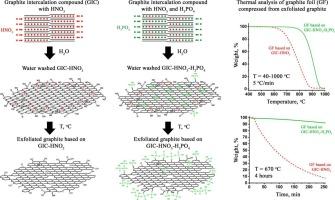含HNO3/H3PO4的石墨插层化合物制备石墨箔:磷化合物在抑制氧化中的作用
IF 5.1
3区 材料科学
Q2 MATERIALS SCIENCE, COATINGS & FILMS
引用次数: 0
摘要
石墨箔(GF)是一种应用广泛的高温密封材料,由可膨胀石墨经热处理而成的剥落石墨压制而成。而可膨胀石墨则是由含有强布朗斯特酸的石墨插层化合物(gic)获得的。然而,在大气中存在氧气的情况下,GF的工作温度受到氧化阈值的限制。本研究的重点是通过添加HNO3/H3PO4的GICs来提高GF的热稳定性。XRD分析表明,与单独添加HNO3相比,H3PO4与HNO3的插入增加了层间距。用HNO3/H3PO4对GICs进行连续水洗,然后进行热膨胀,形成含磷剥落石墨。红外光谱证实了通过分解H3PO4形成的C-O-P键与石墨基体结合的多磷化合物的存在。热重分析结果表明,在高温下,富磷GF的氧化速率和质量损失降低了10倍。此外,用热重曲线研究了氧化动力学。石墨氧化表观活化能的增加表明含磷石墨箔的热稳定性增强,表明磷修饰GF是一种很有前途的高温应用材料。本文章由计算机程序翻译,如有差异,请以英文原文为准。

Graphite foil derived from graphite intercalation compounds with HNO3/H3PO4: Role of phosphoric compounds in oxidation suppression
Graphite foil (GF) is a widely used high-temperature sealing material, produced by pressing exfoliated graphite, which is prepared through the thermal treatment of expandable graphite. Expandable graphite, in turn, is obtained from graphite intercalation compounds (GICs) with strong Bronsted acids. However, the operational temperature of GF is limited by its oxidation threshold in the presence of atmospheric oxygen. This study focuses on enhancing the thermal stability of GF by utilizing GICs with HNO3/H3PO4. XRD analysis revealed that the intercalation of H3PO4 into GIC with HNO3 increases the interlayer spacing compared to HNO3 alone. Sequential water washing of GICs with HNO3/H3PO4, followed by thermal expansion, leads to the formation of phosphorus-containing exfoliated graphite. IR spectroscopy confirmed the presence of polyphosphoric compounds bonded to the graphite matrix via C-O-P bonds, formed through the decomposition of H3PO4. Thermogravimetric analysis of the resulting phosphorus-enriched GF demonstrated a tenfold reduction in oxidation rate and mass loss at elevated temperatures. Additionally, the oxidation kinetic was studied using thermogravimetric curves. The increased apparent activation energy of graphite oxidation indicates enhancement thermal stability of phosphorus-containing graphite foil, suggesting that phosphorus-modified GF is a promising candidate for high-temperature applications.
求助全文
通过发布文献求助,成功后即可免费获取论文全文。
去求助
来源期刊

Diamond and Related Materials
工程技术-材料科学:综合
CiteScore
6.00
自引率
14.60%
发文量
702
审稿时长
2.1 months
期刊介绍:
DRM is a leading international journal that publishes new fundamental and applied research on all forms of diamond, the integration of diamond with other advanced materials and development of technologies exploiting diamond. The synthesis, characterization and processing of single crystal diamond, polycrystalline films, nanodiamond powders and heterostructures with other advanced materials are encouraged topics for technical and review articles. In addition to diamond, the journal publishes manuscripts on the synthesis, characterization and application of other related materials including diamond-like carbons, carbon nanotubes, graphene, and boron and carbon nitrides. Articles are sought on the chemical functionalization of diamond and related materials as well as their use in electrochemistry, energy storage and conversion, chemical and biological sensing, imaging, thermal management, photonic and quantum applications, electron emission and electronic devices.
The International Conference on Diamond and Carbon Materials has evolved into the largest and most well attended forum in the field of diamond, providing a forum to showcase the latest results in the science and technology of diamond and other carbon materials such as carbon nanotubes, graphene, and diamond-like carbon. Run annually in association with Diamond and Related Materials the conference provides junior and established researchers the opportunity to exchange the latest results ranging from fundamental physical and chemical concepts to applied research focusing on the next generation carbon-based devices.
 求助内容:
求助内容: 应助结果提醒方式:
应助结果提醒方式:


